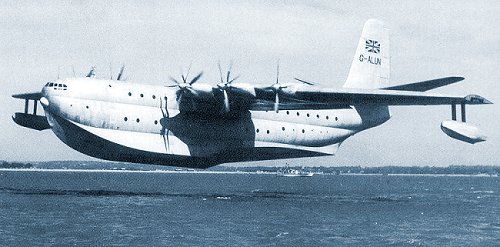The Saro Princess
Today, we'll fly the Princess seaplane. The University of Houston's College of Engineering presents this series about the machines that make our civilization run, and the people whose ingenuity created them.
Let us lay the Spruce Goose aside for a moment. Sure, it was the biggest airplane that ever flew. But only barely! And it blinds us to the other great seaplanes of that era. Take, for example, the great British flying boat started in 1946 by Saro -- the Saunders-Roe Company. It was the Saro Princess.
She was a huge flying boat -- more compact than the Goose, but she also weighed (and could carry) almost as much. She was a whole lot faster and had a far greater range. The Princess was the pinnacle of a technology that died with her.
It seemed obvious before WW-II, that transoceanic service would use flying boats. After all, airplanes were barely reliable. You wanted one that could make an emergency landing on water. During the war, Howard Hughes had bet on that fact and begun building his Spruce Goose. Now the Saro Company made that same bet.
But land-based flight had kept improving (despite the War rather than because of it.) B-17 and B-24 bombers had been able to negotiate the Atlantic. Then they gave way to airplanes like the B-29, which saw extensive service over the Pacific.
The land-based Boeing Stratocruiser had emerged as a leading passenger plane after the War. It was a modified B-29 with a bulbously expanded fuselage. The Stratocruiser and the Saro Princess looked like competitors, with the edge going to the Princess. She was larger, flew about as fast, and had enormous range.
The Stratocruiser was already in service and the Princess would have to unseat her. At first, the lovely Princess, with her sleek lines and ten engines, made the Spruce Goose look antediluvian. But then we find less attractive parallels:
Only three Princesses were made and only one of them flew. The very ambitions of the airplane led to delays. By the time she was being shown off at air shows, intercontinental airports were in place. The Princess would die, even before we had large passenger jets.
Only technological inertia allowed seaplanes to last as long as they did. But inertia is an interesting word: It doesn't just mean resistance to being put in motion; it also means resistance to slowing down, or turning another direction. We've all seen inertia in our computer use. I refused to acknowledge that WordStar was an outmoded word processor, long after I should have.
Yet inertia has its value. We cannot give any new technology the luxury of blowing away the past. We'd lose the lessons of quality that established technologies offer. I learned HTML easily, because it uses so many WordStar features. Railways had virtues that we're still trying to restore: regularity, safety, comfort -- access within our cities. And what a thing of beauty flying boats were! Naturally they lingered beyond their time, uttering their sad "Do not forget me!" cry. No matter that I can recite the reasons they're gone. I still look over my shoulder for them.
I'm John Lienhard, at the University of Houston, where we're interested in the way inventive minds work.
Information about the Saro Princess is scattered about in small pieces in many books on airplanes and web sites. For a superb overview of seaplanes of that vintage, I recommend https://www.seawings.co.uk . This site is dedicated to flying boats in general and to British seaplane pilots in particular. It includes this photo (among many others) of the Saro Princess:
